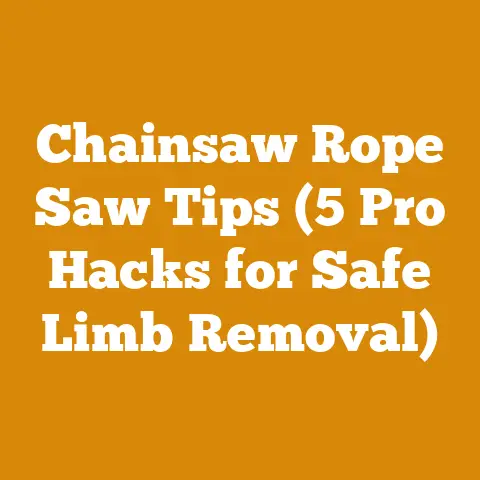How to Clean Up Spilled Chain Oil (Pro Arborist Tips)
How to Clean Up Spilled Chain Oil (Pro Arborist Tips)
Ever been there? You’re in the thick of it, felling a tree, bucking logs, or just topping off your chainsaw, and BAM! A cascade of chain oil coats your saw, your clothes, and maybe even the forest floor. It’s frustrating, messy, and, honestly, a bit embarrassing. I’ve certainly had my share of chain oil mishaps over the years. I remember one particularly sticky situation involving a brand new pair of work boots and a leaky oil reservoir – let’s just say they never quite looked the same again!
But beyond the immediate annoyance, spilled chain oil presents real problems. It’s slippery, a potential fire hazard, and it can contaminate the environment. That’s why knowing how to clean it up properly is crucial. As a pro arborist, I’ve learned a few tricks of the trade over the years, and I’m going to share them with you. We’ll cover everything from the best absorbent materials to environmentally friendly cleanup methods, and even touch on how to prevent spills in the first place. So, let’s get started and keep those chainsaws humming – and our work areas clean!
Understanding Chain Oil: Composition and Concerns
Before we dive into cleanup methods, let’s understand what we’re dealing with. Chain oil isn’t just any lubricant; it’s specifically formulated for high-speed chainsaw chains.
What is Chain Oil Made Of?
Most chain oils are petroleum-based, but many environmentally friendly alternatives are available. Here’s a breakdown:
- Petroleum-Based Chain Oil: This is the traditional option, typically made from refined mineral oil with additives to improve tackiness (to cling to the chain), reduce wear, and prevent rust.
- Vegetable-Based Chain Oil: Derived from renewable resources like rapeseed, sunflower, or canola oil. These are biodegradable and less harmful to the environment. I’ve been using vegetable-based oils more and more in recent years, especially when working near water sources.
- Synthetic Chain Oil: Engineered for superior performance in extreme conditions. They often have better cold-weather flow and higher temperature resistance than petroleum-based oils.
Environmental Impact of Spilled Chain Oil
The environmental impact of spilled chain oil varies depending on the type:
- Petroleum-Based Oil: Can contaminate soil and water, harming plant and animal life. The additives can also be toxic.
- Vegetable-Based Oil: Biodegrades relatively quickly, minimizing environmental impact. However, large spills can still deplete oxygen in waterways as they decompose.
- Synthetic Oil: While often offering superior performance, some synthetic oils may contain chemicals that are persistent in the environment.
Cost of Chain Oil: A Quick Comparison
The cost of chain oil is an important factor for any chainsaw user. Here’s a general comparison:
| Type of Chain Oil | Price per Gallon (USD) | Pros | Cons |
|---|---|---|---|
| Petroleum-Based | \$10 – \$20 | Affordable, widely available. | Environmentally harmful, slower biodegradation. |
| Vegetable-Based | \$20 – \$35 | Biodegradable, environmentally friendly. | More expensive, may require more frequent applications. |
| Synthetic | \$25 – \$40 | Superior performance, good in extreme temperatures, longer chain life. | Most expensive, some may contain persistent chemicals. |
Note: Prices can vary based on brand, retailer, and quantity purchased.
I’ve found that while vegetable-based oils are more expensive upfront, the peace of mind knowing I’m minimizing my environmental impact is worth the extra cost. Plus, I’ve noticed they tend to gum up less than petroleum-based oils when the saw sits unused for extended periods.
Assessing the Spill: Size, Location, and Type of Oil
Before you start cleaning, take a moment to assess the situation. The size, location, and type of oil spilled will influence your cleanup strategy.
Determining the Spill Size
- Small Spill (Less than a Cup): Usually manageable with simple absorbent materials.
- Medium Spill (1 Cup to 1 Quart): Requires more absorbent material and careful containment.
- Large Spill (More than 1 Quart): May require professional cleanup, especially if it reaches a waterway or sensitive area.
Identifying the Location of the Spill
- On Concrete or Asphalt: Easier to clean up as the oil doesn’t readily penetrate the surface.
- On Soil or Grass: More challenging as the oil can seep into the ground. Requires more aggressive cleanup methods.
- Near Waterways: Extremely sensitive. Prevent the oil from reaching the water at all costs. Contact environmental authorities if necessary.
Knowing the Type of Chain Oil Spilled
As discussed earlier, the type of chain oil affects the cleanup methods and environmental concerns. Vegetable-based oils are generally easier to clean up and less harmful than petroleum-based oils.
Essential Cleanup Supplies: A Pro’s Checklist
Having the right supplies on hand is essential for quick and effective cleanup. Here’s my go-to checklist:
- Absorbent Materials:
- Kitty Litter (Clay-Based): A classic and affordable option for absorbing oil on hard surfaces. I always keep a bag in my truck.
- Sawdust: Excellent for absorbing oil on soil or grass. Readily available if you’re already working with wood.
- Oil Absorbent Pads/Mats: Specifically designed to absorb oil and repel water. Ideal for containing spills on concrete or asphalt.
- Commercial Absorbent Granules: Available at auto parts stores and safety supply companies. Often more effective than kitty litter or sawdust.
- Personal Protective Equipment (PPE):
- Gloves (Nitrile or Rubber): Protect your hands from oil and potential irritants.
- Eye Protection (Safety Glasses or Goggles): Prevent oil from splashing into your eyes.
- Respirator (Optional): If you’re working in a confined space with poor ventilation, a respirator can protect you from fumes.
- Tools:
- Shop Rags or Paper Towels: For wiping up small spills and cleaning tools.
- Scraper or Putty Knife: For scraping up thick oil deposits.
- Broom and Dustpan: For sweeping up absorbent materials.
- Buckets or Containers: For collecting used absorbent materials and oil-soaked rags.
- Pressure Washer (Optional): For cleaning concrete or asphalt after the initial cleanup.
- Degreasers/Cleaners:
- Dish Soap: Effective for breaking down oil on hard surfaces.
- Commercial Degreasers: Available at auto parts stores. Follow the manufacturer’s instructions carefully.
- Citrus-Based Cleaners: A more environmentally friendly option for degreasing.
Step-by-Step Cleanup Guide: Different Surfaces, Different Solutions
Now let’s get into the nitty-gritty of cleaning up spilled chain oil on different surfaces.
Cleaning Chain Oil from Concrete or Asphalt
- Contain the Spill: Use oil absorbent pads or kitty litter to create a barrier around the spill and prevent it from spreading.
- Apply Absorbent Material: Cover the entire spill with a thick layer of kitty litter, absorbent granules, or sawdust.
- Let it Sit: Allow the absorbent material to soak up the oil for at least 30 minutes, or longer for larger spills. I usually let it sit overnight if possible.
- Sweep Up: Use a broom and dustpan to sweep up the used absorbent material. Dispose of it properly (see disposal section below).
- Degrease (Optional): If a stain remains, apply a degreaser or dish soap and scrub with a brush. Rinse thoroughly with water.
- Pressure Wash (Optional): For stubborn stains, a pressure washer can be very effective. Be careful not to damage the surface.
Cleaning Chain Oil from Soil or Grass
This is a bit more challenging, as the oil can penetrate the soil.
- Contain the Spill: Create a barrier around the spill using soil, sandbags, or absorbent materials.
- Apply Absorbent Material: Cover the spill with a thick layer of sawdust or commercial absorbent granules.
- Let it Sit: Allow the absorbent material to soak up the oil for several hours or overnight.
- Remove Contaminated Soil: Use a shovel to remove the top layer of soil that is saturated with oil. Place the contaminated soil in a sealed container for proper disposal (see disposal section below).
- Apply a Bio-Remediation Agent (Optional): These products contain microorganisms that break down the oil in the soil. Follow the manufacturer’s instructions carefully. I’ve had good results with bio-remediation agents, but they can be expensive.
- Replace Soil: Fill the excavated area with fresh topsoil and reseed the grass if necessary.
Cleaning Chain Oil from Equipment and Tools
- Wipe Off Excess Oil: Use shop rags or paper towels to wipe off as much oil as possible.
- Apply Degreaser: Spray the affected area with a degreaser or citrus-based cleaner.
- Scrub: Use a brush or sponge to scrub the surface and remove the oil.
- Rinse: Rinse thoroughly with water.
- Dry: Dry the equipment or tool with a clean cloth.
Cleaning Chain Oil from Clothing
Chain oil on clothing can be a real pain.
- Pre-Treat: Apply a stain remover or dish soap directly to the oil stain.
- Launder: Wash the garment in hot water with a strong detergent.
- Air Dry: Do not put the garment in the dryer until the stain is completely removed. The heat from the dryer can set the stain.
- Repeat: You may need to repeat the process several times to remove the stain completely.
Environmentally Friendly Cleanup Methods: Minimizing Your Impact
As arborists, we have a responsibility to protect the environment. Here are some environmentally friendly cleanup methods:
- Use Vegetable-Based Chain Oil: As mentioned earlier, vegetable-based oils are biodegradable and less harmful to the environment.
- Choose Biodegradable Absorbent Materials: Opt for sawdust, peat moss, or other natural absorbent materials.
- Use Citrus-Based Cleaners: These cleaners are derived from citrus fruits and are less toxic than traditional degreasers.
- Consider Bio-Remediation: Bio-remediation agents use microorganisms to break down oil in the soil, reducing the need for excavation and disposal.
- Proper Disposal: Dispose of used absorbent materials and contaminated soil properly (see disposal section below).
Proper Disposal of Used Materials: Following Regulations
Proper disposal of used absorbent materials, oil-soaked rags, and contaminated soil is crucial to prevent further environmental damage.
- Check Local Regulations: Contact your local environmental agency or waste management company to determine the proper disposal methods in your area.
- Containerize Waste: Place used absorbent materials, oil-soaked rags, and contaminated soil in sealed containers, such as plastic bags or drums.
- Label Containers: Clearly label the containers as “Oil-Contaminated Waste” and include the date and type of oil.
- Dispose at a Designated Facility: Take the containers to a designated hazardous waste disposal facility or landfill that accepts oil-contaminated waste.
- Do Not Dump: Never dump oil-contaminated waste down drains, into waterways, or on the ground.
In many areas, there are specific regulations regarding the disposal of oil-contaminated waste. For example, in the United States, the Environmental Protection Agency (EPA) regulates the disposal of hazardous waste under the Resource Conservation and Recovery Act (RCRA). Failure to comply with these regulations can result in fines and penalties.
I remember one time, a colleague of mine tried to “save money” by dumping some oil-soaked rags in a dumpster behind a local business. He ended up getting a hefty fine from the city and a stern warning from the EPA. It’s just not worth the risk.
Preventing Chain Oil Spills: Proactive Measures
The best way to deal with a chain oil spill is to prevent it from happening in the first place. Here are some proactive measures:
- Use a Funnel: When filling your chainsaw oil reservoir, use a funnel to prevent spills.
- Don’t Overfill: Avoid overfilling the reservoir, as this can cause oil to leak out.
- Check for Leaks: Regularly inspect your chainsaw for leaks. Pay close attention to the oil reservoir, hoses, and fittings.
- Tighten Fittings: Make sure all fittings are tight. Loose fittings can cause oil to leak.
- Use a Drip Tray: When storing your chainsaw, place it on a drip tray to catch any leaks.
- Transport Safely: When transporting your chainsaw, secure it properly to prevent it from tipping over and spilling oil.
- Choose Quality Chain Oil: Using a high-quality chain oil can reduce wear and tear on your chainsaw, which can help prevent leaks.
- Maintain Your Chainsaw: Regular maintenance can help prevent leaks and other problems.
Cost Analysis of Cleanup and Prevention: A Balancing Act
Let’s talk about the economics of chain oil spills. There are costs associated with both cleaning up spills and preventing them.
Costs of Cleaning Up Chain Oil Spills
- Materials: Absorbent materials, degreasers, cleaning supplies, etc.
- Labor: Your time spent cleaning up the spill.
- Disposal Fees: Fees for disposing of oil-contaminated waste.
- Environmental Fines: Fines for violating environmental regulations.
- Reputation Damage: Negative publicity can damage your reputation and cost you business.
Costs of Preventing Chain Oil Spills
- Equipment: Funnels, drip trays, etc.
- Maintenance: Regular chainsaw maintenance.
- Training: Training employees on proper handling and storage of chain oil.
- Higher Quality Chain Oil: Vegetable-based or synthetic oils are often more expensive.
Cost-Benefit Analysis
The key is to find a balance between the costs of cleaning up spills and the costs of preventing them. In my experience, investing in prevention is almost always more cost-effective in the long run.
For example, let’s say you have a small logging operation. You estimate that you have one chain oil spill per month, each costing you \$50 in materials and labor to clean up. That’s \$600 per year.
Now, let’s say you invest \$200 in preventative measures, such as funnels, drip trays, and employee training. This reduces the number of spills to one per year. The cost of cleaning up that one spill is \$50.
In this scenario, you’ve saved \$350 per year by investing in prevention (\$600 – \$250 = \$350).
Data on Spill Costs
While precise data on the cost of chain oil spills is hard to come by, here’s some relevant information:
- EPA Fines: The EPA can fine companies thousands of dollars for violating environmental regulations related to oil spills.
- Cleanup Costs: According to the EPA, the average cost of cleaning up an oil spill can range from hundreds to millions of dollars, depending on the size and location of the spill.
- Lost Productivity: Time spent cleaning up spills is time that could be spent on more productive tasks.
Case Studies: Real-World Examples of Spill Management
Let’s look at some real-world examples of how companies and individuals have managed chain oil spills.
Case Study 1: Logging Company
A logging company in Oregon had a history of chain oil spills at its logging sites. The company was fined by the state environmental agency for violating water quality regulations.
- Training employees on proper handling and storage of chain oil.
- Providing employees with spill kits containing absorbent materials and cleaning supplies.
- Regularly inspecting logging sites for leaks and spills.
- Developing a spill response plan.
As a result of these efforts, the company significantly reduced the number of chain oil spills and avoided further fines.
Case Study 2: Arborist
An arborist in California spilled chain oil on a client’s lawn while pruning a tree. The arborist immediately cleaned up the spill using absorbent materials and degreaser.
To prevent further damage, the arborist also applied a bio-remediation agent to the soil. The client was impressed with the arborist’s prompt and responsible response, and the lawn recovered quickly.
Case Study 3: Firewood Supplier
A firewood supplier in Maine had a large chain oil spill at its storage yard. The spill contaminated a nearby stream.
The supplier was required to excavate the contaminated soil and dispose of it at a hazardous waste landfill. The supplier also had to pay a significant fine to the state environmental agency.
This case study highlights the importance of preventing large chain oil spills and having a plan in place to respond quickly and effectively if a spill does occur.
Actionable Takeaways: Your Chain Oil Spill Prevention and Cleanup Plan
Here’s a summary of the key takeaways and actionable steps you can take to prevent and clean up chain oil spills:
- Understand Chain Oil: Know the different types of chain oil and their environmental impact.
- Assess the Spill: Determine the size, location, and type of oil spilled.
- Gather Supplies: Keep a well-stocked spill kit on hand.
- Clean Up Properly: Follow the step-by-step cleanup guides for different surfaces.
- Use Environmentally Friendly Methods: Minimize your impact by using vegetable-based oil, biodegradable absorbent materials, and citrus-based cleaners.
- Dispose of Waste Properly: Follow local regulations for disposing of oil-contaminated waste.
- Prevent Spills: Implement proactive measures to prevent spills from happening in the first place.
- Conduct a Cost-Benefit Analysis: Weigh the costs of cleaning up spills against the costs of preventing them.
- Learn from Case Studies: Study real-world examples of spill management.
- Create a Plan: Develop a written spill prevention and cleanup plan for your operation.
Final Thoughts: A Clean Cut is a Safe Cut
Cleaning up spilled chain oil is more than just tidying up; it’s about environmental responsibility, safety, and cost management. By understanding the nature of chain oil, having the right tools and knowledge, and taking proactive measures, you can minimize the risk of spills and ensure a cleaner, safer work environment. Remember, a clean cut is a safe cut – and a responsible one. Now, go forth and keep those chainsaws humming, and keep those spills to a minimum!






